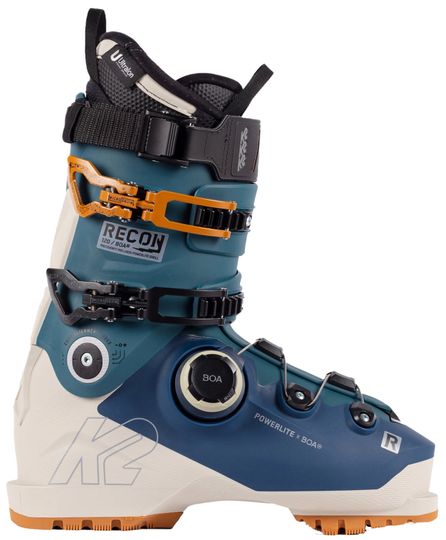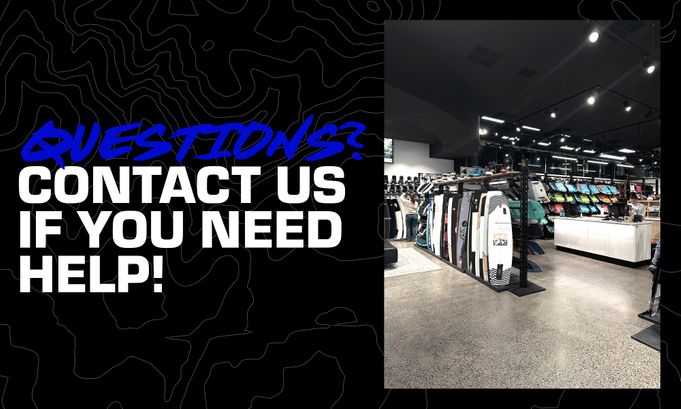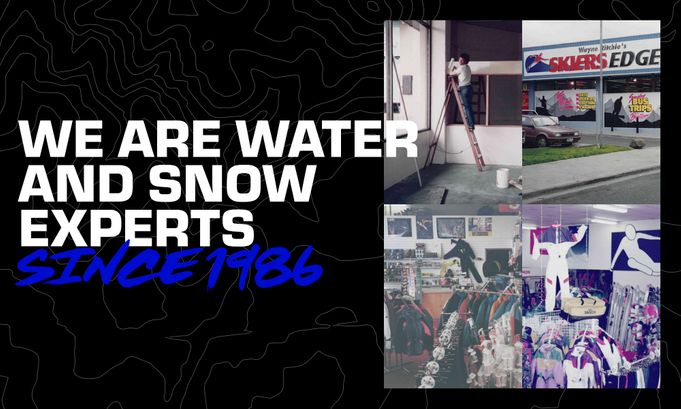Snow ski boots are arguably the most critical component of a ski setup, as they provide the connection between your feet and the skis themselves. Choosing new snow ski boots is an important decision that can greatly impact your snow ski experience. While the overall fit and feel of a boot comes down to a skier’s personal preference, there are several components of a boot that are important to consider:
- FLEX: The flex of a ski boot refers to the amount of stiffness or resistance in the boot when it is bent forward at the ankle. It is typically measured on a scale of 60 to 130 for adults, with a lower number indicating a softer flex and a higher number indicating a stiffer flex. A softer flex is typically best for beginner skiers and for those who prefer a more relaxed and forgiving ride, as it allows for more flexion in the ankle. A stiffer flex is suited to advanced skiers and for those who want more precision and control as it offers more support and responsiveness when carving and skiing at speed.
- LAST: The last of a snow ski boot refers to the width of the boot at its widest point, from the 1st to 5th metatarsal. It's measured in millimetres, and it generally ranges from narrow to wide, typically between 92mm to 106mm. The last width of a ski boot can affect the overall fit of the boot, and it's important to find a last width that matches the width of your foot for a comfortable and supportive fit. A boot that is too narrow can cause discomfort, such as pinching or cramping and can lead to cold toes, as the circulation can be restricted. On the other hand, a boot that is too wide can also lead to poor performance, as the foot may move too much inside the boot, causing instability and a lack of support and response.
- FIT & SIZE: A proper fit is essential for comfort and performance. Your heel should be held securely in place and should not slip inside the boot when you flex your ankle forward. There should be no pressure points or hotspots on your foot, as this can indicate that the boot is too tight or too wide. Your toes should be touching the end of the boot when you are standing up straight, but there should still be enough room to allow your toes to move slightly when you are flexing your ankle. When you try on the boots, you should be wearing the same socks you plan to wear while skiing.
CONSTRUCTION & MATERIALS:
Snow ski boots are typically made from a combination of different materials, including plastic, foam, and metal. Each material offers its own unique set of properties, which can affect the performance, durability, and price of the boot. The price of a ski boot is determined by several factors, including the materials used, the design, and the brand. Boots made with higher-quality materials and advanced technologies tend to be more expensive, but they also offer greater performance.
- PLASTIC: Plastic is the most common material used in the construction of ski boots. Most plastics are lightweight, durable, and relatively inexpensive. The plastics in ski boots can vary greatly depending on the flex and price.
- FOAM: Foam is used in the construction of the boot's liner, it's a material that can be shaped to fit the skier's foot, it's also lightweight and warm. Foam liners can be made from different types of foam, such as closed-cell and open-cell. Most quality ski boot liners can be heat moulded.
- METAL: Metal is often used in the construction of ski boots to increase strength and stability and is always used for parts such as the buckles. Metal can be used in the construction of the boot's spine to increased rigidity and performance.
K2 2024 Recon 120 Boa Snow Ski Boots
- Online
- Ringwood Store
Description
BOA® on ski boots? Yep, you read that right. It’s the biggest advancement in skiing, let alone boot fitting in sixty years. You’ve seen this feature on snowboard boots, bike shoes, and even running shoes, so it’s about time we put our heads together with the minds at BOA® Fit System to bring something new to skiing, with a laser focus on performance.
Harnessing the power of a BOA® Fit System, K2 engineers got to work delivering our most adjustable fit with performance-enhancing features. The Recon 120 BOA® boots boast a redesigned lower cuff, with an all-new shell, delivering a tighter toe seal.
Say goodbye to all your boot-fitting woes, with the new Recon 120 BOA® . Its redesigned shell delivers a better “wrap,” and a more even pressure distribution across the foot. Gone are traditional pain hotspots caused by overtightened buckles, the Recon 120 BOA® boots are outfitted with a micro-adjustable fit, even pressure distribution and an unmatched heel hold.
We’ve named this all-new boot last our MultiFit™️ last, ranging from 97mm -104mm. Fitting a wide range of feet right out of the box and eliminating the need for both a “Low Volume” and “Mid Volume” fit.
There’s so much tech inside the Recon 120, it’s hard to know where to start. A heat-moldable liner provides the perfect balance between comfort and support. We’ve integrated internal and external J-Bars to ensure proper heel hold and made the toebox seamless, making the fitting process smooth as silk.
Building on the success of boot board technology, we’ve added customizable heel inserts to be able to fine-tune the feel. The boot board inside the Recon 120 BOA® comes with a rigid and responsive heel insert, and this boot also ships with a softer, damper, Harshmellow™️ insert for more impact absorption.
The leader in performance ski boots just got upped a notch. Get your eyes on (and your feet in) the new Recon 120 BOA®, and be a part of the next wave of ski technology.
Shipping ETA
| DESTINATION | Small Items < 1kg | Large Items |
| Melbourne Metro | 1 Business Day | 1 Business Day |
| Victoria | 1-3 Business Days | 1-3 Business Days |
| New South Wales | 1-3 Business Days | 1-3 Business Days |
| Queensland | 1-3 Business Days | 1-3 Business Days |
| South Australia | 1-3 Business Days | 1-3 Business Days |
| Tasmania | 2-5 Business Days | 2-5 Business Days |
| Western Australia | 2-5 Business Days | 2-5 Business Days |
| Northern Territory | 3-7 Business Days | 3-7 Business Days |
Warranty
Products sold by Wayne Ritchie's come with consumer guarantees and a minimum manufacturer warranty of 12 months. A manufacturers warranty covers defects that occur during the manufacturing process that result in the product having poor performance or being unfit for use. The manufacturers' warranty does not cover misuse or accidental damage. Minor faults such as delaminations, broken clips, ratchets, laces and tube inners or other replaceable parts will be repaired in a reasonable time frame. Serious faults that hinder use and cannot be repaired such as cracks and tears will be replaced, or a store credit issued for the same value. In the event of a defect, please visit Wayne Ritchies in-store, or submit via the online form. Purchase history must be provided for all claims so please submit your original purchase receipt or invoice. In some cases, a bank statement showing the original purchase date is applicable.
Shipping & Returns
SHIPPING POLICY
Large items over 1 metre cannot be shipped to PO Boxes or Parcel Lockers. Large items are shipped by courier so please provide us with a business or street address where someone will be present at the delivery address between 9am-5pm to sign for the delivery. If you are not present when delivery is attempted we cannot guarantee it will be re-delivered in a timely manner. It may be returned to us or allocated to a third party company which we have no control over, and a re-delivery fee may be incurred in some instances. Once your order has been shipped you will be provided with a tracking number to follow the progress of your order online. It is the full responsibility of the receiver to ensure someone is present at the specified delivery address as there will be no compensation by Wayne Ritchie's for lost or missing parcels. All deliveries notated with "leave at front door" or similar will be left at the buyer's risk, no responsibility will be taken by Wayne Ritchie's for lost or missing parcels.
Incorrect addresses: In the event that you enter an incorrect or invalid address causing your order to be returned to us, a $20 fee will be charged before we can re-send the order to you a second time.
Pick-up in-store: Your click and collect order will typically be ready with 4 hours of placing your online order (during business hours) but this timeframe may differ on weekends and during late night trade periods. PLEASE DO NOT arrive to collect your order until you have received a pick-up confirmation email.
Pre-order items: we cannot provide guaranteed shipping dates but pre-orders are given priority and will be shipped immediately the same day the goods arrive in our warehouse.
We endeavour to keep our extensive online range as up-to-date as possible but if you cannot find what you're looking for, please Contact Us and we will do our best to find it for you.
RETURNS POLICY
Wayne Ritchie's Skiers Edge offers free returns for items that are faulty, not as described or incorrect item shipped. Please return the item to us within 14 days of date of purchase and will will issue a refund or replacement. If you change your mind, an item does not fit or the wrong size is ordered it can be returned to us in the brand new condition you received it and we will happily exchange it or issue a refund. PLEASE NOTE: it is the buyer's responsibility to pay return shipping on change of mind, items that do not fit or have been incorrectly ordered.
*Conditions Apply.
PLEASE NOTE:
- Sale items are offered at significantly discounted prices so please choose carefully as we WILL NOT accept exchanges or returns on sale items.
- Wayne Ritchie's reserves the right to cancel any online order without notice.
- It is the responsibility of the customer to adhere to our terms and conditions as stated above.
- To view our full terms and conidtions Click Here
Visit Us in Store
Experience the largest Australian water sports and snow sports pro-shop in-store! We welcome our customers to enjoy the most immersive range of skis, boards and accessories.
Shipping ETA & Returns
Enjoy free express shipping on all orders over $100, or just $12.95 express shipping on all orders under $100. We'll dispatch orders on the same day if ordered before 12pm.
Get in Touch
We're here to help! If you've got a question regarding our products or services, click below for our phone and email contact details or send us a message via Facebook Messager.
About Us
Wayne Ritchie's is a specialty watersports and snowsports retailer, family owned and operated since 1986. We pride ourselves on an unrivalled customer experience.







